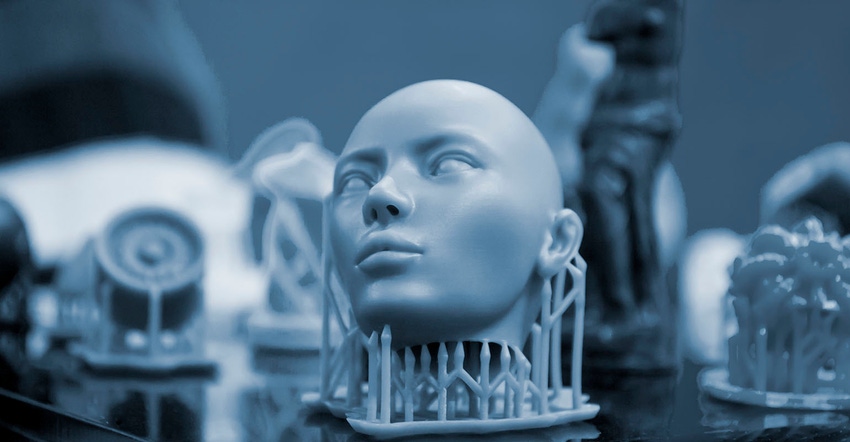3D printing will not completely displace conventional production methods, but injection molders would be foolish to dismiss it out of hand.
February 22, 2023

Paul K. Steck
It’s not the future — it’s the present. And here's the proof. Advances in 3D printing over the past few years have been dynamic, and so has its impact on numerous industries. Everything from medical prosthetics to residential construction to the physical infrastructure of our cities and towns has now been demonstrated to be achievable with the application of this technology. Most, if not all, industries are applying the benefits of 3D printing. Audi Motors already uses it to make a few specific parts, and 3D printers and parts are also present on warships and employed tactically in numerous military scenarios.
So, where will 3D printing boldly go next? How about outer space?
A bioprinter designed to print human tissue has been installed in the International Space Station since 2019. In the not-too-distant future, further space exploration will require 3D-printing technology. If we plan to colonize another planet, 3D printing will allow us to build dwellings and other structures rapidly — and more cost-efficiently — with indigenous materials. We are just inches away from this becoming a reality.
3D printing in zero gravity
NASA is steeped in the use of 3D printing. In December 2019, it published a document about its programs, “Solving the Challenges of Long Duration Space Flight with 3D Printing.” The In-Space Manufacturing (ISM) project at the NASA Marshall Space Flight Center (MSFC) focuses on producing spare parts, tools, and materials on demand for routine needs during long voyages and being ready to quickly respond to unforeseen events. In-space manufacturing using 3D-printing technology could be a solution. 3D printing under zero gravity conditions has already successfully produced dozens of parts, demonstrating that the lack of gravity has little to no impact on an item’s dependability or quality.
For manufacturing, the advantages of 3D printing and additive technology include:
Flexible design and more complicated designs, such as lattice work, which may be created and printed with 3D printing more effectively and efficiently than by conventional manufacturing techniques.
Rapid prototyping. The speed of 3D printing greatly reduces the time from approved drawing to finished prototypes and even final production runs.
3D-printed parts are relatively light weight and can be highly durable.
Cost effectiveness. The process is more economical than using hard tooling; the technology is far less costly than creating molds and it eliminates the need for expensive tooling for the initial 200 to 20,000 pieces of a product that typically would be injection molded. And once the design has been approved, printing on demand becomes a welcome convenience.
Large-format printing often eliminates the need to weld parts together, reducing labor cost and time, and resulting in overall increased part strength. For example, we recently created prototypes for a customer’s trade show in Paris, saving them time and money. Beyond prototyping, quick and less-expensive short production runs are now a reality.
3D printing vs. injection molding
This begs the question: Will other traditional plastic molding processes become obsolete?
While 3D printing offers numerous advantages, it will not completely displace conventional production methods. It is still a developing technology with hurdles that should be considered when choosing a product development approach. Manufacturers and product designers should view it as a process that complements conventional production. They may use its special qualities to enhance product design and even create parts that would be impossible to make any other way. Yet, in the near future, 3D printing and additive technology could be a replacement for certain plastic molding processes. Why? Because it will eliminate the need for costly silicone or rubber molds, as well as the other advantages cited above. Our own company experienced a 17.5% growth in 2022, a portion of which is attributable to additive manufacturing. We even produce housings for a company that manufactures 3D printers.
In his article, “Is 3D Printing the Future of Manufacturing?” in Industry Today, David Spergel posits that the future is drawing near. Rapid and affordable mass manufacturing utilizing 3D printing needs to become faster and less expensive. Currently, additive manufacturing, as a whole, is too sluggish for large-run manufacturing, even though it is useful for small-scale runs. The technology, nonetheless, will expand its footprint and continue to combine with already in-place processes. As 3D printing matures, producers will have their own road plan for profiting from it. For large-scale efficiency, the post-processing cycle for the majority of goods is laborious, but our company specializes in high-quality finishing of plastic parts, and we have proven in side-by-side comparison that 3D parts can provide the level of quality OEMs require.
Is there a downside to 3D printing? Besides the learning curve for staff, the process produces a somewhat rough textured output that requires expert finishing. Not all companies are equipped for this. As previously mentioned, Exothermic Molding already had in-house automotive-quality finishing prior to entering the 3D space. When done right, it is nearly impossible to distinguish between a molded part and an additive part in a side-by-side comparison, as you can see in the photo below.
|
Can you tell which of these parts was made by 3D printing and which one was injection molded? By applying expert finishing techniques, it's almost impossible to tell them apart. |
The speed of new developments in this technology is remarkable. In just the short time since we purchased and installed our large-format 3D printer, the manufacturer has been able to increase the machine’s speed by a factor of three.
Business owners need to invest in their companies to keep pace with fast-changing technology. This investment will produce a quick return on investment based on growing demand for these services. In addition, many investments may qualify for R&D tax credits. And business owners need to invest in their people, too. At Exothermic, we created a dedicated operating unit within the company to handle our customers’ increasing needs in additive manufacturing. In tandem with our HR consultants, we created a career pathway for entry level employees to develop and progress through a series of levels of competency.
In the end, a new dimension in manufacturing has no doubt arrived.
|
About the author
Paul K. Steck is the president of Exothermic Molding Inc., a third-generation, family-owned specialty plastics manufacturer in Kenilworth, NJ, serving a variety of verticals including healthcare, laboratory sciences, and defense.
You May Also Like




